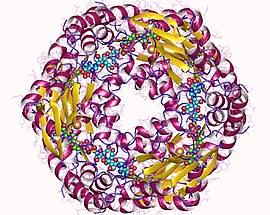| guanylate kinase | |||||||||
|---|---|---|---|---|---|---|---|---|---|
 guanylate kinase homohexamer, E.Coli | |||||||||
| Identifiers | |||||||||
| EC no. | 2.7.4.8 | ||||||||
| CAS no. | 9026-59-9 | ||||||||
| Databases | |||||||||
| IntEnz | IntEnz view | ||||||||
| BRENDA | BRENDA entry | ||||||||
| ExPASy | NiceZyme view | ||||||||
| KEGG | KEGG entry | ||||||||
| MetaCyc | metabolic pathway | ||||||||
| PRIAM | profile | ||||||||
| PDB structures | RCSB PDB PDBe PDBsum | ||||||||
| Gene Ontology | AmiGO / QuickGO | ||||||||
| |||||||||
| guanylate kinase | |||||||||||
|---|---|---|---|---|---|---|---|---|---|---|---|
 Structure of Guanylate Kinase.[1] | |||||||||||
| Identifiers | |||||||||||
| Symbol | Guanylate_kin | ||||||||||
| Pfam | PF00625 | ||||||||||
| InterPro | IPR008144 | ||||||||||
| PROSITE | PDOC00670 | ||||||||||
| SCOP2 | 1gky / SCOPe / SUPFAM | ||||||||||
| CDD | cd00071 | ||||||||||
| |||||||||||
In enzymology, a guanylate kinase (EC 2.7.4.8) is an enzyme that catalyzes the chemical reaction
Thus, the two substrates of this enzyme are ATP and GMP, whereas its two products are ADP and GDP.
This enzyme belongs to the family of transferases, specifically those transferring phosphorus-containing groups (phosphotransferases) with a phosphate group as acceptor. This enzyme participates in purine metabolism.
Guanylate kinase catalyzes the ATP-dependent phosphorylation of GMP into GDP.[1] It is essential for recycling GMP and indirectly, cGMP. In prokaryotes (such as Escherichia coli), lower eukaryotes (such as yeast) and in vertebrates, GK is a highly conserved monomeric protein of about 200 amino acids. GK has been shown to be structurally similar to protein A57R (or SalG2R) from various strains of Vaccinia virus.[2][3][4] Systems biology analyses carried out by the team of Andreas Dräger also identified a pivotal role of this enzyme in the replication of SARS-CoV-2 within the human airways.[5][6][7]
- ^ a b Stehle T, Schulz GE (April 1992). "Refined structure of the complex between guanylate kinase and its substrate GMP at 2.0 A resolution". J. Mol. Biol. 224 (4): 1127–41. doi:10.1016/0022-2836(92)90474-X. PMID 1314905.
- ^ Bryant PJ, Woods DF (February 1992). "A major palmitoylated membrane protein of human erythrocytes shows homology to yeast guanylate kinase and to the product of a Drosophila tumor suppressor gene". Cell. 68 (4): 621–2. doi:10.1016/0092-8674(92)90136-Z. PMID 1310897. S2CID 46607652.
- ^ Zschocke PD, Schiltz E, Schulz GE (April 1993). "Purification and sequence determination of guanylate kinase from pig brain". Eur. J. Biochem. 213 (1): 263–9. doi:10.1111/j.1432-1033.1993.tb17757.x. PMID 8097461.
- ^ Goebl MG (March 1992). "Is the erythrocyte protein p55 a membrane-bound guanylate kinase?". Trends Biochem. Sci. 17 (3): 99. doi:10.1016/0968-0004(92)90244-4. PMID 1329277.
- ^ Renz, Alina; Widerspick, Lina; Dräger, Andreas (2020). "FBA reveals guanylate kinase as a potential target for antiviral therapies against SARS-CoV-2". Bioinformatics. 36 (Supplement_2): i813–i821. doi:10.1093/bioinformatics/btaa813. PMC 7773487. PMID 33381848. S2CID 229929774.
- ^ Renz, Alina; Widerspick, Lina; Dräger, Andreas (2021). "Genome-Scale Metabolic Model of Infection with SARS-CoV-2 Mutants Confirms Guanylate Kinase as Robust Potential Antiviral Target". Genes. 12 (6): 796. doi:10.3390/genes12060796. PMC 8225150. PMID 34073716. S2CID 235300463.
- ^ Leonidou, Nantia; Renz, Alina; Mostolizadeh, Reihaneh; Dräger, Andreas (2023). "New workflow predicts drug targets against SARS-CoV-2 via metabolic changes in infected cells". PLOS Computational Biology. 19 (3): e1010903. Bibcode:2023PLSCB..19E0903L. doi:10.1371/journal.pcbi.1010903. PMC 10035753. PMID 36952396. S2CID 257715107.
